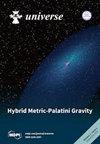Direct and Indirect Measurements of the 19F(p,α)16O Reaction at Astrophysical Energies Using the LHASA Detector and the Trojan Horse Method
IF 2.5
4区 物理与天体物理
Q2 ASTRONOMY & ASTROPHYSICS
引用次数: 0
Abstract
Fluorine is one of the most interesting elements in nuclear astrophysics. Its abundance can provide important hints to constrain the stellar models since fluorine production and destruction are strictly connected to the physical conditions inside the stars. The 19F(p,α)16O reaction is one of the fluorine burning processes and the correction evaluation of its reaction rate is of pivotal importance to evaluate the fluorine abundance. Moreover, the 19F(p,α)16O reaction rate can have an impact for the production of calcium in the first-generation of Population III stars. Here, we present the AsFiN collaboration efforts to the study of the 19F(p,α)16O reaction by means of direct and indirect measurements. On the direct measurements side, an experimental campaign aimed to the measurement of the 19F(p,α0,π)16O reaction is ongoing, taking advantage of the new versatile arrays of silicon strip detectors, LHASA and ELISSA. Moreover, the Trojan Horse Method (THM) was used to determine the 19F(p,α0)16O reaction S(E)-factor in the energy range of astrophysical interest (Ecm≈ 0–1 MeV), showing, for the first time, the presence of resonant structures within the astrophysical energy range. THM has been also applied for the study of the 19F(p,απ)16O reaction; data analysis is ongoing.利用 LHASA 探测器和特洛伊木马法直接和间接测量天体物理能量下的 19F(p,α)16O 反应
氟是核天体物理学中最有趣的元素之一。由于氟的生成和破坏与恒星内部的物理条件密切相关,因此它的丰度可以为恒星模型的约束提供重要提示。19F(p,α)16O反应是氟燃烧过程之一,对其反应速率的校正评估对于评估氟丰度至关重要。此外,19F(p,α)16O 反应速率对第一代种群 III 恒星中钙的生成也有影响。在这里,我们介绍了AsFiN合作通过直接和间接测量来研究19F(p,α)16O反应的工作。在直接测量方面,目前正在利用新型多功能硅带探测器阵列 LHASA 和 ELISSA,开展旨在测量 19F(p,α0,π)16O 反应的实验活动。此外,还利用特洛伊木马法(THM)测定了天体物理学感兴趣的能量范围(Ecm≈ 0-1 MeV)内的 19F(p,α0)16O反应 S(E)因子,首次显示了天体物理学能量范围内共振结构的存在。THM 还被用于研究 19F(p,απ)16O 反应;数据分析正在进行中。
本文章由计算机程序翻译,如有差异,请以英文原文为准。
求助全文
约1分钟内获得全文
求助全文
来源期刊

Universe
Physics and Astronomy-General Physics and Astronomy
CiteScore
4.30
自引率
17.20%
发文量
562
审稿时长
24.38 days
期刊介绍:
Universe (ISSN 2218-1997) is an international peer-reviewed open access journal focused on fundamental principles in physics. It publishes reviews, research papers, communications, conference reports and short notes. Our aim is to encourage scientists to publish their research results in as much detail as possible. There is no restriction on the length of the papers.
 求助内容:
求助内容: 应助结果提醒方式:
应助结果提醒方式:


